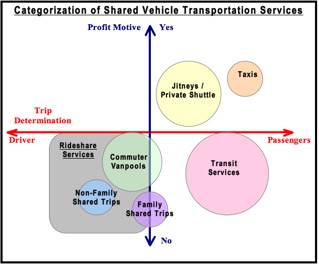The distinction between ridesharing and public transit is not always clear. An argument could be made that the major differences between the two are the capacity of the vehicle, and the participant that determines whether a trip is undertaken (driver or passenger). The vehicle capacity distinction should be obvious; transit frequently (but not always) operates larger vehicles such as trains and buses whereas ridesharing often occurs in smaller vehicles such as cars and passenger vans. While transit’s primary purpose is to transport multiple passengers to a destination, ridesharing differs in that it generally occurs when the driver is planning on undertaking a trip and seeks out a passenger who is willing to share the ride. In other words, transit trips operate with an implied understanding that service is based on passenger demand and if sufficient communal demand does not exist (such as on weekends) the driver will not undertake the trip (service will be reduced). Ridesharing, on the other hand, is better described as a trip that the driver intends on taking whether or not they can find an appropriate passenger to share the ride with.
The “vehicle capacity” and “trip determined by driver or passenger” characteristics alone are not entirely satisfying. If one considers taxi trips, they take place in small vehicles where the passenger dictates the purpose of the trip. Essentially, taxi trips are neither a form of transit or ridesharing according to the distinction laid out in the previous paragraph. A further refinement is the absence of a profit-seeking motive on the part of the driver in rideshare arrangements. Whereas taxi drivers are profit seeking in their carriage of passengers, rideshare drivers in most cases seek only to share the costs of transport. In fact, in some jurisdictions such as Colorado, government legislation mandates that financial transactions only reflect the sharing of trip costs.
The three characteristics of ridesharing (smaller vehicle capacities, the trip is determined by the driver’s needs and the lack of profit motive) allows for the categorization of most forms of shared vehicle transportation. The figure below presents a categorization of shared vehicle transportation where driver/passenger trip determination is on the horizontal axis, profit motive is on the vertical axis and the size of the circles represents the relative capacity of the vehicles used.

Based on the shared transport characteristics described above, we have proposed a definition of ridesharing as follows:
“the transportation of two or more individuals in a motor vehicle with a capacity not exceeding 15 passengers, when such transportation is incidental to the principal purpose of the driver, which is to reach a destination, and when such transportation does not seek to transport persons for profit.”
This definition incorporates the three characteristics described earlier in this chapter. Further, it addresses the issue of “unsustainable ridesharing”, whereby an initial rideshare journey results in an SOV return journey because the trip is undertaken to meet the needs of the passenger. “Unsustainable ridesharing” is not uncommon in school trips, where parents will drive their child to school but will return home alone. Since the definition states that the driver’s principal purpose determines the trip being undertaken, multi-occupant trips catering to the passenger’s trip purpose should not count as ridesharing according to a strict interpretation of this definition.
This definition does create some important measurement limitations. The inclusion of driver trip purpose in the definition makes the identification of rideshare trips much more difficult, and certainly more onerous than simply counting vehicles with at least two occupants. Yet, the inclusion of driver trip purpose is a very important addition to the definition of ridesharing, particularly from a policy standpoint. Ridesharing is often described as a sustainable alternative to traveling alone and is encouraged by different levels of government. Clearly the sustainability of this mode rests on the ability to combine two unique trips that would have otherwise occurred separately. When travel demand leads to the creation of a new vehicle-based trip, part of which is an SOV trip, it undermines the message that ridesharing is a sustainable mode. Ideally, the measurement of rideshare participation should differentiate between multi-occupant trips undertaken based on driver vs. passenger trip purpose, and only assign credit to those where the driver’s trip purpose dictated travel. To operationalize this definition, more precise travel diaries and surveys would need to be administered specifically asking participants what the purpose of their trip was, and seeking more detailed information on trip-chaining tendencies.